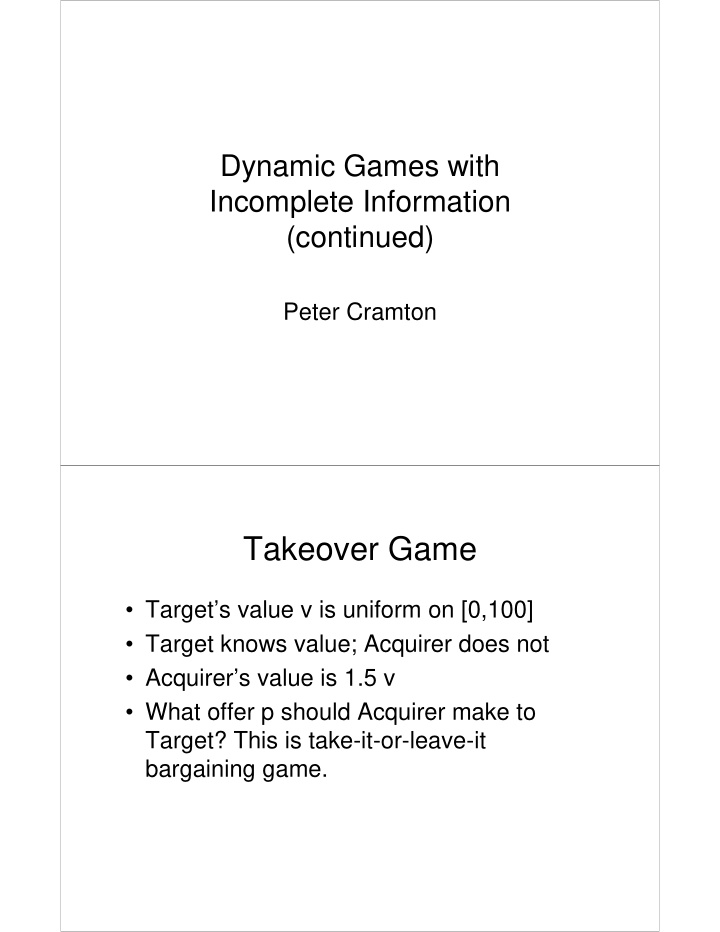



Dynamic Games with Incomplete Information (continued) Peter Cramton Takeover Game • Target’s value v is uniform on [0,100] • Target knows value; Acquirer does not • Acquirer’s value is 1.5 v • What offer p should Acquirer make to Target? This is take-it-or-leave-it bargaining game.
Auctions • Auctions are important institution. • Understanding auctions should help us understand the formation of markets by modeling the competition on one side of the market. • Auctions represent an excellent application of game theory, since in an auction the rules of the game are made explicit. Simple Auctions Auctions typically take one of four simple forms: Oral Sealed Bid English ( ↑ price) 2nd Price Dutch ( ↓ price) ≡ 1st Price
Simple Auctions • English : price increases until only one bidder is left; the remaining bidder gets the good and pays the highest bid. • Dutch : prices decreases until a bidder accepts the price; this bidder gets the good and pays the price at acceptance. • Second Price : each bidder submits a bid in a sealed envelope; the highest bidder gets the good and pays the second highest bid. • First Price : each bidder submits a bid in a sealed envelope; the highest bidder gets the good and pays the amount of his bid. Auction Exercise • Bid for single object • Common value = $1 per bean • On slip of paper write: – Name – Estimate (# of beans × $1) – Bid in first-price sealed-bid auction – Bid in second-price sealed-bid auction
Models of Private Information (1) Independent Private Value: v i ~ F i independently of v j for j ≠ i. (2) Common Value: e i = v + ε i , ε i ~ F i w/ mean 0. (3) Affiliated Value: v i (x,s), my value depends on private information x = (x 1 ,...,x n ) and state of world s. Winner's Curse I won. Therefore, I overestimated the most. My bid only matters when I win, so I should condition my bid on winning (i.e., that I overestimated the most). • Winning is bad news about my estimate of value. This is a form of adverse selection that arises in any exchange setting: if you want to trade with me, it must be that no one else offered more, because they did not think that the item is worth what I am willing to pay.
Models of Private Information • Independent private value model: It makes sense if differences in value arise from heterogeneous preferences over the attributes of the item • Common Value: It makes sense if the bidders have homogeneous preferences, so they value the item the same ex post, but have different estimates of this true value. • Affiliated value model: In this model, each bidder has private information that is positively correlated with the bidder's value of the good. Auction Multiple Items • 2 bidders (L and S), 2 identical items • L has a value of $100 for 1 and $200 for both • S has a value of $90 for 1 and $180 for both • Uniform-price auction – Submit bid for each item – Highest 2 bids get items – 3 rd highest bid determines price paid • Ascending clock auction – Price starts at 0 and increases in small increments – Bidders express how many they want at current price – Bidders can only lower quantity as price rises – Auction ends when no excess demand (i.e. just two demanded); winners pay clock price
What if private information? • 2 bidders (L and S), 2 identical items • L has constant marginal value u drawn U[0,1] • S has constant marginal value v drawn U[0,1] • Uniform-price auction – Submit bid for each item – Highest 2 bids get items – 3 rd highest bid determines price paid • Ascending clock auction – Price starts at 0 and increases in small increments – Bidders express how many they want at current price – Bidders can only lower quantity as price rises – Auction ends when no excess demand (i.e. just two demanded); winners pay clock price
Recommend
More recommend